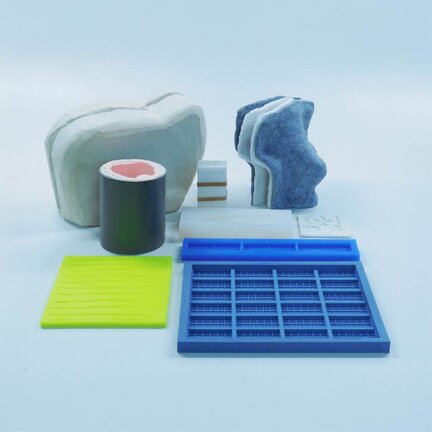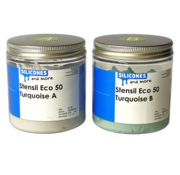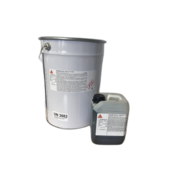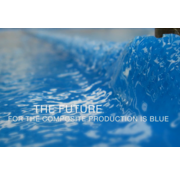Making molds with silicone, alginate and many other producs
Making molds with silicone and accessories. With silicone you can make your own molds in no time. How? Just go to the bottomofthi page for Tips and Tricks!
Silicone Addition Yellow 25 Set
€ 31,50 € 26,03 Excl. tax
✔ Flexible, Strong
Compare
✔ Yellow
✔ Shore (A) 25 (Moderately Hard)
✔ Low shrinkage (<0.1%)
✔ 60 minutes working time
✔ Mixing ratio (Weight) 100: 100T40 B component for condensatie silicone
€ 5,87 € 4,85 Excl. tax
✔ 2-3% dosage
Compare
✔ Medium fast
✔ Can be used pure or mixed
✔ Low shrinkage (< 0.3%)Silicone Condensation 20 for Polyester
€ 19,18 € 15,85 Excl. tax
✔ Flexible, Strong, good resistance to polyester
Compare
✔ White, Good Fluid, Bleeding
✔ Shore (A) 23 ~ 26
✔ Low shrinkage (<0.3%)
✔ 120 minutes working time
✔ Mix ratio (Weight) 100:5T47 B component for condensation silicone
€ 6,05 € 5,- Excl. tax
✔ Very fast
Compare
✔ Low dosage
✔ Can be used neat or mixed
✔ Retain properties of other hardener at low dosage
✔ Low shrinkage (< 0.3 %)
✔ 5 minutes working time
✔ Mixing ratio (Weight) 100:2Wacker Elastosil M 1470 Kneadable silicone
€ 255,75 € 211,36 Excl. tax
✔ Kneading compound, Strong
Compare
✔ Pink
✔ Shore (A) 45 (Flexible Stiff)
✔ Low shrinkage (<0.2%)
✔ 10-20 minutes working time
✔ Mixing ratio (Weight) 100: 2 ~ 5Stensil ECO 50 Turquoise
€ 21,- € 17,36 Excl. tax
✔ Kneadable silicone, Strong, Turquoise
Compare
✔ Shore (A) 50
✔ Low shrinkage (< 0.1 %)
✔ 90 Seconds working time @ 20°C
✔ Mixing Ver. (Weight)100:100Formwork Kit for silicone molds - Aluminium 24 x 4 cm.
€ 44,95 € 37,15 Excl. tax
✔ useful for quickly making a casing
Compare
✔ including clamps
✔ adjustable size, which means less wastage of material
✔ lasts a long time
✔ indispensable tool for the professionalWacker Elastosil RT 480 Spreadable silicone
€ 48,95 € 40,45 Excl. tax
✔ Pasty (250,000 mPa s)
Compare
✔ Strong
✔ Light gray
✔ Shore (A) 55 (Flexible Stiff)
✔ Low shrinkage (0.25 to 0.5%)
✔ 20 or 120 minutes working time
✔ Mixing ver. (Weight)100:3 or 4Epoxy Support Cap EPOPAST 402/400
€ 338,- € 279,34 Excl. tax
✔ Low odor
Compare
✔ Low density
✔ Easy processing
✔ Temperature resistant 70°CFormwork Kit for silicone molds - Aluminium 49 x 8 cm.
€ 57,50 € 47,52 Excl. tax
✔ useful for quickly making a casing
Compare
✔ including clamps
✔ adjustable size, which means less wastage of material
✔ lasts a long time
✔ indispensable tool for the professionalT51 B component for condensatie silicone
€ 6,05 € 5,- Excl. tax
✔ 5% dosage
Compare
✔ dry, stretchy result
✔ Can be used neat or mixed
✔ Low shrinkage (< 0.3%)
✔ Better resistance to polyester
✔ Mixing ratio (Weight) 100:5ELASTOSIL® C 1200 A/B
€ 453,66 € 374,93 Excl. tax
✔ Suitable for the production of reusable silicone vacuum bags.
Compare
✔ Fast curing at room temperature
✔ No chemical shrinkage
✔ Resistance to epoxy resins
✔ Resistance to polyester
✔ Two components 1:1
✔ blue / Transparent- Pay later with Klarna
- 30 Days return period!
- Advice from real Experts
Formwork Kit for silicone molds - Aluminium 49 x 4 cm.
€ 50,- € 41,32 Excl. tax
✔ useful for quickly making a casing
Compare
✔ including clamps
✔ adjustable size, which means less wastage of material
✔ lasts a long time
✔ indispensable tool for the professionalT37 B component for condensation silicone
€ 5,55 € 4,59 Excl. tax
✔ 3-4% dosage
Compare
✔ dry, stretchable result
✔ Can be used neat or mixed
✔ Low shrinkage (< 0.3%)
✔ Better resistance to PU and Epoxy
✔ Mixing ratio (Weight) 100:5
✔ Long processing timeFormwork Kit for silicone molds - Plastic 20 x 4 cm.
€ 34,95 € 28,88 Excl. tax
✔ useful for quickly making a casing
Compare
✔ shape into square or triangle
✔ adjustable size
✔ including clampsT40 Paste B component for condensation silicone
€ 25,24 € 20,86 Excl. tax
✔ 2% dosage
Compare
✔ Medium fast
✔ Can be used pure or mixed
✔ Low shrinkage (< 0.3%)
✔ Mainly used for Elastosil M 1470Hard addition silicone for molds QM 272
€ 0,- € 0,- Excl. tax
✔ Flexible, Strong
Compare
✔ Beige
✔ Shore (A) 70 (Hard)
✔ Viscosity 35,000 mPa s
✔ 60 minutes working time
✔ Mixing ratio by weight: 100:10
✔ Good resistance to resinsT35 B component for condensation silicone
€ 5,88 € 4,86 Excl. tax
✔ 5% dosage
Compare
✔ Medium fast
✔ Can be used pure or mixed
✔ Low shrinkage (< 0.3%)

Do you want to make a silicone or alginate mold yourself? This is of course possible with the products and the help of Siliconesandmore!
Here you will find many videos and tutorials on how to easily make a one-stop alginate mold or how to make a beautiful silicone mold from a candle or soap or whatever you like!
Due to the flexibility and the good resistance to aging due to UV radiation and temperature, molds are often made of silicone. Some silicones can withstand temperatures of up to 380 C° for short periods and are therefore suitable for metals with a low melting point.
For many applications, pourable 2-component silicone that cures at room temperature is sufficient. We really have many varieties of these, so if you can't see the forest for the trees, consult our silicone guide or give us a call!
For additional tensile strength we recommend the use of silicone compounds (silicone pastes) which normally cure at higher temperatures. This is often a little more for the professional user.
Silicone molds are often made by placing the original model in a box and pouring silicone over it. This method is quick and easy, but costs more silicone and often results in a less flexible mold. Larger images, odd shapes and delicate products are often made with a spatula mold. To do this, the silicone is thickened and spread over the statue like butter. The resulting silicone skin must of course retain its shape. A support cap is therefore made of epoxy or acrylic resin, for example.
Molds are used for many things. Be it the production of statues in concrete, cement, polyurethane, polyester, etc. or even making sweets. These molds are often made of silicone because of its flexibility and good resistance to aging by UV and temprature. Some silicone can withstand temperatures of 380 ° C for short periods of time and are therefore suitable for metals with low melting point like some tin compounds.
Silicones come in many different types, from one component silicone sealant to two or more components liquid silicone which harden at room temperature. In industrial applications one often uses silicone compounds which are processed with presses or injection machines at higher temperature.
For many applications, a two component room temeprature hardening silicone will do the trick, but for added strength, we recommend the use of silicone compounds (silicone paste) which usually harden at higher temperatures.
Moulds are often made via the casting process in which the original is placed in a container and silicone is poured over it. With more demanding or bigger models however it is easier to make the silicone paste like and brush it against the model. The silicone skin thus obtained has got a lot of detail but no dimensional stability. For this you would need a support hull made e.g. form epoxy or Acrylic resin.





